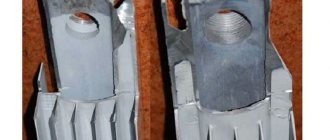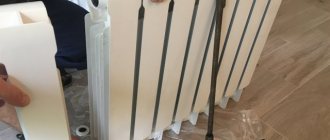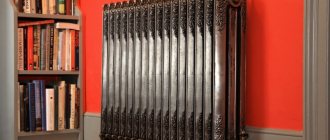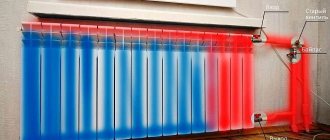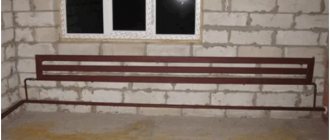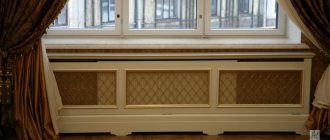Modern aluminum heating radiators are very popular. Such equipment can be seen both in city apartments and in offices. They are especially often installed by owners of private and country houses. The technical parameters of the batteries make them an excellent option for one-, two- and three-story buildings. The article discusses the device, characteristics, advantages and disadvantages, the main models of aluminum batteries, and also describes how to disassemble, assemble and wash an aluminum radiator.
Aluminum battery device
When considering the design of an aluminum heating radiator, it should be noted that the design of the battery can be solid or sectional.
A sectional aluminum heater consists of 3-4 separate sections. As a rule, titanium, silicon, and zinc are added to aluminum. These metals make the product stronger and more resistant to tearing and corrosion. All sections are connected to each other using a threaded connecting element. Silicone gaskets are used to seal the connection. The radiators have a polymer coating inside to prevent the possibility of battery rupture.
Solid aluminum radiators consist of profiles. Profiles are made by extrusion.
No additional metals are added to aluminum radiators.
What gives plasticity to the material. The profiles are connected to each other by welding. This connection is highly durable and reliable. Like sectional ones, one-piece radiator models are coated inside with a polymer layer.
Depending on the production method, there are radiators made by casting, extrusion and anodized products (made from aluminum of a higher purity).
Technical characteristics of aluminum heating radiators
Due to its high technical characteristics, many people decide to buy an aluminum radiator for heating their apartment. The main technical parameters include:
- operating pressure. It ranges from 10 to 15 atmospheres. In residential apartments, operating pressure can exceed the norm by 3-4 times. In this regard, such radiators are rarely installed in city houses. But for private homes, such a heater will be an ideal solution;
- crimping pressure. Located in the range from 20 to 50 atmospheres;
- heat transfer coefficient. For the standard section it is 82-212 W;
- the maximum coolant temperature can reach +120 degrees;
- one section can weigh from 1 to 1.5 kg;
- capacity of each section is from 0.25 to 0.46 l;
- the distance between the axes can be 20, 35, 50 cm. There are models in which this parameter can reach 80 cm.
The manufacturer indicates the parameters for each radiator model in the device passport. Considering the technical characteristics of aluminum heating radiators, the price for them is quite justified and depends on the type of battery, the number of sections and the manufacturer.
Advantages and disadvantages of aluminum radiators
Before you buy aluminum heating radiators, you need to consider what advantages and disadvantages this device has.
The main advantage of an aluminum battery is its compactness and much lighter weight than cast iron systems. You can read more about cast iron heating radiators here. The equipment warms up very quickly and transfers heat well to the room. The service life is quite long. Another advantage is the division into sections - it is possible to select the desired length of the battery. It should be noted that for aluminum radiators the price is indicated per section. This makes it easy to calculate the approximate cost of a sectional device.
Since the equipment is small and weighs little, it is easy to install. Installation can even be carried out on a plasterboard wall. Modern models look aesthetically pleasing and stylish. Aluminum is easy to process. This gives manufacturers the opportunity to experiment with battery design. You can choose an option for any interior. Aluminum radiators are most suitable for autonomous heating systems. Despite the high technical characteristics and a lot of advantages, the price of aluminum heating batteries is quite affordable.
The disadvantages of aluminum radiators include low resistance to corrosion. And this can greatly affect the overall condition of the battery. Aluminum is a fairly active metal by nature. If the oxide film covering the surface is damaged, the protective layer will be destroyed due to the release of hydrogen. To increase anti-corrosion properties, a polymer coating is used. If the battery does not have a polymer coating, then you cannot turn off the taps on the supply pipes. Otherwise, the battery may rupture under pressure.
Today, aluminum batteries occupy a leading place in sales of heating equipment.
Many people prefer to buy this type of heating device because of its relatively low cost. For aluminum heating radiators, the average price per section is about 230-300 rubles.
Autonomous heating system
Autonomous heating scheme
What parameters should you be guided by when choosing a boiler, and how is the heating radiator designed? This is only a few of the issues that the owner of a private house has to solve when planning a heating system. First, a heating circuit is developed, its main parameters are determined - operating temperature, number and location of radiators, control devices.
The next step is to find out how a heating boiler works and choose the optimal model
This is very important, as it will directly affect the efficiency and characteristics of the entire heating circuit of the house
Heating boiler design
Gas boiler design
The operating principle of any boiler is to receive thermal energy from an energy carrier (coal, firewood, gas, diesel fuel) and transfer it to the coolant. The design of a heating boiler directly depends on the type of fuel used. Let's look at this using the example of the most common models - gas.
The main component in this case is the burner. In it, the energy from hot gas is transferred to water using a heat exchanger. In solid fuel models, this function is performed by the combustion chamber. In addition, boilers often contain the following components:
- Water supply system to the heat exchanger;
- Chimney pipe for removing carbon monoxide;
- Control elements - control of flame intensity, CO2 content, draft, water temperature, etc.;
- Circulation pump - designed to increase the speed of coolant movement. It is not included in the package of most solid fuel and some gas boilers;
- Expansion tank and security system.
When choosing gas models, you need to pay special attention to the presence of a second circuit intended for DHW. It is not recommended to purchase a boiler whose power is higher than required
This will lead to an increase in energy consumption and, as a result, an increase in financial costs for maintenance.
It is not recommended to purchase a boiler whose power is higher than required. This will lead to an increase in energy consumption and, as a result, an increase in financial costs for maintenance.
Installation of heating radiators
Sectional view of a heating battery
The design of the heating radiator has not changed for many years. Despite the use of new manufacturing materials and improvements in the appearance of the battery, when creating it, they are always guided by a proven scheme.
On what principles is the design of a standard heating battery based? It must consist of two components - pipelines through which the coolant flows and a heat exchange surface. When designing, they try to increase thermal output and at the same time reduce the useful volume of the transport route. For this purpose, materials with an increased heat transfer rate are used in the design of the heating radiator - aluminum, copper, etc.
It is important for the user to pay attention to the following parameters of the standard heating battery device:
Rated power, W. Manufacturers indicate the value of this characteristic at a certain temperature condition of the system. For example - 70/55 or 90/70;
Sectional or panel model. For the former, there is the possibility of increasing the usable area by adding sections;
Connection method
This is important to know when analyzing the design of a heating system in an apartment building. If there is an upper pipe distribution, you should purchase models with a side connection.
In addition to installing radiators, their correct piping must be provided. Its components are shut-off valves and a Mayevsky valve. For greater efficiency, it is recommended to install a temperature-controlled valve.
One of the main factors for the normal operation of the radiator is its correct installation and connection. If the standards are not followed, its efficiency may decrease by 10-15%.
Review of aluminum battery manufacturers
Today, many models of aluminum radiators from different manufacturers are sold on the market. Therefore, you can easily select the aluminum heating radiators that best suit your technical parameters, external design and financial capabilities.
You can purchase the desired model on the market, in a specialized store. Aluminum heating radiators are also sold via the Internet. The advantage of such a purchase is that it saves time. If you have any questions regarding the parameters of the equipment, you can ask them to an online consultant or call the phone number listed on the website and chat with the manager.
It should be noted that for heating radiators, prices for aluminum, steel or cast iron models in the online store are usually lower than the market average. Therefore, many people prefer to order heating devices online.
Both imported and domestic products are available for sale. Naturally, prices for domestically produced aluminum heating radiators are lower than for foreign analogues. But this does not affect the quality of the product. Since many modern domestic batteries are produced using Italian technology. Among domestic manufacturers, it is necessary to highlight the companies Rifar and Thermal. They produce durable aluminum heating devices at reasonable prices.
Since Italian aluminum heating radiators have always been famous for the highest quality, they are very popular on the market, despite their high cost. Here we should note the products of Fondital, Sira and Global. These companies also produce bimetallic heating radiators. Hungarian-made heating devices are also popular. True, they are inferior in quality to Italian models. Good aluminum batteries are produced by the Hungarian company NAMI.
Flaws
Aluminum radiators also have some disadvantages, and it would be unfair not to mention them. The disadvantages of aluminum radiators include the following:
- Possibility of leakage between radiator sections;
- Low convective capacity;
- Quite a high probability of gas formation;
- Heat concentration on radiator fins.
The accumulation of gases is dangerous because the heating system may fail or the gases may cause a radiator explosion. This problem can be prevented by first installing air vents on aluminum heating radiators, which will operate automatically.
Aluminum as a metal has quite high activity, so such radiators are more susceptible to corrosion, as reviews show.
To prevent this problem, you can use an inactive chemical film or carry out additional anti-corrosion preparation of the heating device.
Aluminum radiator installation diagrams
It should be noted that the connection of aluminum heating radiators can be carried out according to different schemes. Aluminum batteries are suitable for single-pipe and two-pipe wiring. In the latter version, the supply and discharge pipes are connected in parallel; they are connected through the final device of the heating system.
There are the following methods for connecting aluminum heating radiators: side, diagonal and bottom. Each of the schemes differs not only in the battery installation technology, but also in the quality of heat transfer.
Diagonal connection
The most common and effective method is a diagonal connection. In this case, heat loss does not exceed 2%. Ideal for equipment with a large number of sections. The outlet pipeline is connected to the bottom one. The supply pipe is connected to the upper pipe. This method is used for two-pipe heat supply systems.
Side connection
With a lateral connection, the supply pipe is connected from above, and the outlet pipe from below. Installation is carried out to the pipes, which are located on one side. In the lower version, the connection is made to the pipes, which are located at the bottom of the battery. True, the thermal output in this case is 15% lower than the rated power of the device.
Before connecting an aluminum heating radiator, the device must be properly assembled. The manufacturer describes the installation technology and assembly features in detail in the instructions that come with the equipment.
Calculation of the number of sections
To effectively heat a particular room, a certain number of battery sections will be required. If there are not enough of them, the system will not be able to warm up the home in winter. To correctly calculate the quantity, there are special formulas.
The first option is by area. This method is used if the ceiling height in the room is standard, not higher than 2.6 m.
The formula looks like this: N = S × 100/Q, where:
- S is the area of the room;
- Q is the thermal power parameter of section 1;
- N is the required number of sections.
It is recommended to round up, with a margin.
The second option is a calculation for a room with a non-standard ceiling height, by volume. Based on the recommendations of SNiP, heating 1 m3 of area requires 41 W of equipment power. The formula is: N = V × 41/Q. The letter “V” indicates the volume of the room.
Even if the calculations were made incorrectly, you should not be upset. Aluminum batteries can be expanded, that is, additional sections can be added to them. To do this, you will need a special key for radiators, and the blocks themselves are connected using steel nipples.
How to assemble a radiator?
Aluminum heating radiators are assembled according to the following algorithm:
- place the battery on a flat surface;
- Inspect each threaded connection for chips, cracks and thoroughly clean with sandpaper. Degrease the ends using gasoline. Gaskets can be washed in soapy water;
- connect the sections. To do this, you need to put the seals on the nipple nut and place them on both sides of the device section. Make a couple of turns with the key in the upper and lower holes. When the key stops turning, you can pull it out using the lever;
- A plug should be placed on the unused hole. And on the other side, attach a Mayevsky valve to remove excess air from the system. Now the radiator can be connected to the system according to the selected scheme.
Purpose of thermostat elements
All functional elements included in the thermostat include:
- thermal valve;
- thermal element;
- thermal sensitivity element;
- connector;
- transmission rod;
- spool valve;
- union type nut;
- compensator;
- fixation ring;
- scale.
The thermoelement has the form of an element that is equipped with a cylinder filled with a working composition that strongly reacts to any changes in temperature around, and its walls from the inside are made in compliance with corrugation technology. This mechanism is called a bellows.
When the temperature increases, the volume of the working medium also increases, which, in turn, causes the working rod to move and block the movement of the coolant. If the temperature drops, the volume of the working medium, on the contrary, decreases, thereby compressing the bellows itself. This leads to reverse movement of the rod, which opens the way for the coolant to the heating radiator. A similar cycle of compression and expansion in modern devices is repeated a huge number of times, which makes it possible to operate them for a very long time.
How to disassemble an aluminum battery?
Sometimes situations arise when you need to disassemble the battery. For example, it is necessary to add additional sections to the radiator or replace one of the sections that has leaked. In any case, you need to know how to disassemble an aluminum heating radiator correctly.
Battery parsing algorithm:
- dismantle the radiator. To do this, you must first shut off the flow of coolant into the system. The threaded connection is unscrewed using a wrench;
- remove the radiator and place it face up on the floor;
- disassemble the device into separate sections. The sections can be disconnected using a radiator wrench. Insert it into the grooves of the nipple nut of the upper hole and make several turns counterclockwise. Do the same with the bottom hole. Section disconnected.
Classification by type of coolant circulation
According to the method of creating liquid circulation, private heating systems are divided into two types: gravity (with natural circulation) and pumping (with forced movement).
Before installation, you should take into account the operating principles of each equipment and select the most suitable one for the building conditions.
Natural circulation systems
The natural movement of water is caused only by physical processes. Liquid moves under pressure.
With the correct layout of such a system, heating will depend only on the natural water pressure. Failures, if all conditions are met, are extremely rare.
With forced circulation
If the building is built in an area with unstable water levels, experts recommend installing equipment with forced circulation. A special pump is built in to ensure constant movement of the coolant.
Design and operating principle
The principle of operation of a radiator is that the heated energy carrier moves through a pipe system and enters the batteries, transfers heat, then moves along the return branch to the heating source. A radiator heats the air in a room using radiation and convection. Different types of devices have different ratios of thermal radiation and convection.
Steel and cast iron radiators heat the room by radiation, and plate and panel heaters transfer energy by convection due to the large total area of ribs and strips. The warm flow tends upward; in return, cold air is drawn in, which heats up.
Three-way valve
An unconventional device for regulating the temperature of heating devices is a three-way valve. It is placed at the connection between the bypass and the supply pipe that goes to the battery. In order for the valve to perform the function of stabilizing the heating level of the radiator, it must have a thermostatic head. If the temperature near the head rises above the required value, the supply of coolant to the battery stops, and the liquid flow moves through the bypass. When cooling occurs, the valve opens again and the radiator heats up. This adjustment method is suitable for single-pipe systems with vertical wiring.
Important! In homes with a central heating system, the coolant usually contains foreign particles that clog thermostats. Therefore, you can safely install manual taps or valves, as well as three-way valves in your apartment.
If you want to install automatic heat regulators, you must install filters in front of them, which will have to be cleaned regularly.
